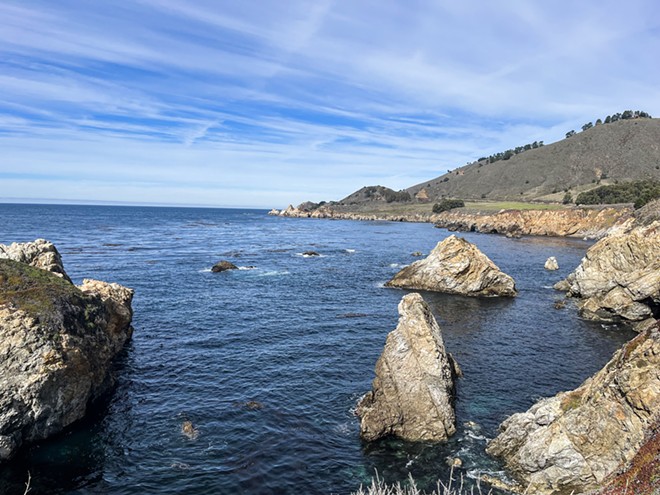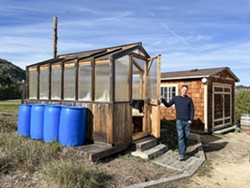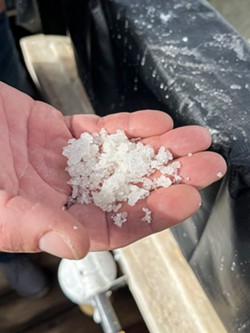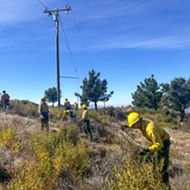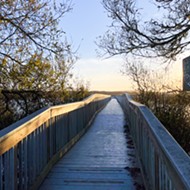Outdoor Kitchen: Carlo Overhulser crafts artisan salt with some help from the Pacific Ocean
A taste of Big Sur
By Camillia Lanham[{
"name": "Ad - Medium Rectangle CC01 - 300x250",
"id": "AdMediumRectangleCC01300x250",
"class": "inlineCenter",
"insertPoint": "8",
"component": "2963441",
"requiredCountToDisplay": "12"
},{
"name": "Ad - Medium Rectangle LC01 - 300x250",
"id": "AdMediumRectangleCC01300x250",
"class": "inlineCenter",
"insertPoint": "18",
"component": "2963441",
"requiredCountToDisplay": "22"
},{
"name": "Ad - Medium Rectangle LC09 - 300x250",
"id": "AdMediumRectangleLC09300x250",
"class": "inlineCenter",
"insertPoint": "28",
"component": "3252660",
"requiredCountToDisplay": "32"
}]
Freezing and wet on a winter day in 2015, he was in awe of the 30-foot-tall calamity that just soaked him.
“We get the big storms through here, and I like to go watch the waves slam into the rocks,” Overhulser said. “I thought that was a cool moment. So I kept the water in there and took it home.”
He picked the bottle up, deposited it in his yard, and promptly forgot about it. About a month later, he noticed some white stuff in the bottle and tasted it.
The briny hint left on his tongue got him wondering. He filled some roasting pans with ocean water and left them in the yard, thinking if the sun does its thing again, maybe he could turn that sea salt into something more.
Big Sur Salts, Overhulser’s company, now harvests 25,000 pounds of salt a year out of the Pacific Ocean along the northern Big Sur coastline in Monterey County. His salt and salt blends are used in 42 restaurants and sold at 127 retail locations and are available through Big Sur Salts’ online storefront.
“I’d never thought about doing salt before, never thought about doing anything like that before,” he said. “And now I’m in the thick of it.”
Overhulser’s company has grown from roasting pans and natural cliffside seawater ponds that he found while exploring the coast into a collection of greenhouses, natural ponds, and a permit to pump ocean water, which gets filtered down to 0.1 micron, so all that’s left is the salt and minerality.
“All of the water I use for salt is filtered to that limit,” he said. “It’s the cleanest salt on the market. … That’s huge. It’s non-negotiable.”
He also creates special blends with ingredients sourced from within 300 miles of the Big Sur coast, naming them for his favorite trails and spots in Big Sur.
Chef Kenny Seliger at In Bloom in Paso Robles said Big Sur Salts give their dishes a cleaner, more elevated flavor. Seliger said he uses Big Sur Salts’ flake as a finishing salt and replaced kosher salt in the restaurant with Overhulser’s Pico Blanco.
“The first time I tried Big Sur, it was equal to, if not better than, Maldon, plus it comes from the Pacific Ocean,” Seliger said, adding that In Bloom’s goal is to support California growers as much as possible. “It just was a natural connection, and being able to fly that flag that we have our own salt made here in California is just an awesome bonus.”
Pico, he said, really helps enhance the flavor of things like carrots without taking over.
“It helps a carrot taste like a carrot in the way that it’s supposed to,” Seliger said.
He said he hasn’t been up to see where Big Sur Salts is made yet, but that trip is on his bucket list. Overhulser often offers chefs salt tours out to the cliffside ponds he continues to harvest a portion of his salt from.
Some of those ponds can produce 2,000 pounds of salt a year. About 15 gallons of water yields 3 ounces of salt.
The process is fairly simple—all it takes is time and the right conditions.
Comfortable with the pounding surf below, Overhulser nimbly scampers along the same rocky face that changed his fate in 2015. He walks above the ocean to an indentation filled with water just south of Rocky Point.
“You can see all the way through the water,” he says on a crisp day in November 2022. “It’s crystal clear. You can tell that it just got there.”
As that water warms and begins to evaporate, the pool will change color, Overhulser adds. Green algae shows up and begins to do its thing, eventually altering the pH of the water and enabling little red eggs to hatch brine shrimp, “essentially sea monkeys.” Those monkeys eat the green algae, again changing the water’s color.
The water gets darker, drawing in more sunlight and speeding up evaporation.
“Eventually the water will heat up so much that nothing can live anymore and the crystals start to form. Once those start to form, I’ll know how long until I need to harvest,” he says. “That was all stuff I had to learn while I was doing it.”
In a greenhouse, the process is even simpler. He transports filtered water to spots like a greenhouse at Carmel Valley Ranch, where it evaporates in temperatures that can reach up to 180 degrees Fahrenheit, forming delicate salt crystals on the surface and sides of the containers that hold the water. The resulting salt is developed specifically for the Carmel Valley Ranch, but there are 17 other greenhouses that Big Sur Salts operates.
Those greenhouses can produce salt year-round, but the ponds need a good winter of giant waves to feed them. Overhulser says he often can start harvesting salt from them in January.
He walks beyond the pond, jumping down a series of small boulders to get closer to the water. Spray wafts into the air as another wave hits the rocky wall beneath his feet.
“Every time I come down here I get all energized, just because I feel all of this,” Overhulser says.

